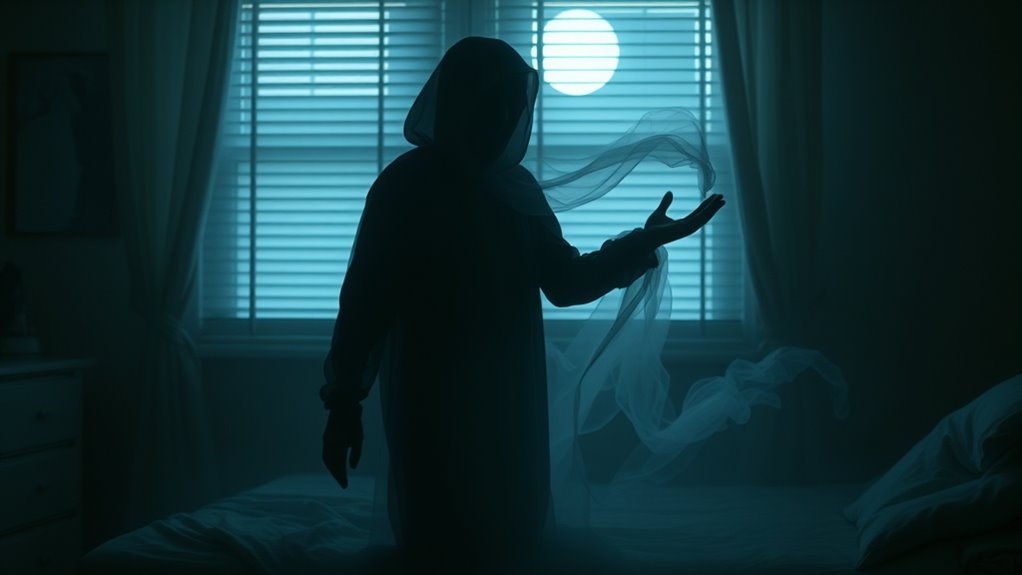Sleep paralysis is a common, temporary experience where your body stays immobile even though you’re awake, often accompanied by vivid hallucinations. Myths suggest it’s supernatural, but facts show it’s linked to disruptions in your sleep cycles, especially REM. To cope, stay calm, focus on breathing, and remind yourself it will pass. Understanding these facts and strategies can help you manage episodes better—keep going to learn important tips to reduce fear and regain control.
Key Takeaways
- Sleep paralysis is a temporary, harmless phenomenon caused by disrupted sleep cycles, often accompanied by frightening hallucinations.
- Myths include beliefs that it is dangerous or supernatural; facts show it’s a common, manageable sleep experience.
- Maintaining regular sleep schedules and good sleep hygiene reduces the likelihood of episodes.
- Staying calm, practicing controlled breathing, and gentle movements help alleviate paralysis during episodes.
- Understanding the connection between sleep paralysis and lucid dreaming can empower individuals to manage or prevent episodes effectively.

Sleep paralysis can be a terrifying experience that catches you off guard, often leaving you feeling helpless and confused. During these episodes, your body is unable to move despite being fully conscious, and you might see or sense terrifying hallucinations. It’s a common phenomenon linked to disruptions in your sleep cycle dynamics, which involve the natural progression of REM and non-REM sleep stages. Understanding how sleep cycle dynamics work can help you grasp why sleep paralysis occurs, especially when REM sleep becomes disjointed or intrudes upon wakefulness.
One way to make sense of sleep paralysis is through the lens of lucid dreaming. Lucid dreaming occurs when you realize you’re dreaming while still in the dream state, often allowing you to control the dream environment. Interestingly, sleep paralysis and lucid dreaming are closely related because both involve heightened awareness during REM sleep. In some cases, people intentionally use techniques like lucid dreaming to either prevent or induce sleep paralysis, as they learn to navigate the boundary between waking and dreaming states. Recognizing the signs of a lucid dream can help you differentiate between a vivid dream and a sleep paralysis episode, reducing fear and panic.
To cope with sleep paralysis, it’s essential to understand and manage your sleep cycle. Disruptions, such as irregular sleep schedules, stress, or sleep disorders, can increase the likelihood of experiencing paralysis. Maintaining a consistent sleep routine helps stabilize your sleep cycle dynamics, reducing episodes. If you do find yourself paralyzed, staying calm is key. Remember that the episode is temporary and not harmful. Focus on slow, controlled breathing and try to relax your muscles as much as possible. Some people find that moving their fingers or toes gently can help break the paralysis.
Practicing good sleep hygiene also plays a significant role in prevention. Avoid caffeine and alcohol close to bedtime, and create a comfortable, dark sleep environment. Techniques like mindfulness meditation can reduce stress, which is often a trigger for sleep disturbances. If you’re prone to sleep paralysis, keeping a sleep journal can help identify patterns or triggers, so you can adjust your habits accordingly. Understanding the interplay between sleep cycle dynamics and lucid dreaming gives you insights into your sleep patterns, allowing you to better prepare for and manage these episodes. Additionally, using a home theatre projector can enhance your relaxation routine, creating a calming environment conducive to sound sleep. Ultimately, knowledge and good sleep practices empower you to face sleep paralysis with confidence, transforming a frightening experience into an opportunity for self-awareness and control.
Frequently Asked Questions
Can Sleep Paralysis Occur During Any Stage of Sleep?
Sleep paralysis typically occurs during shifts between dream states and wakefulness within your sleep cycles. It doesn’t happen during any stage of sleep, but mostly during REM sleep when your muscles are relaxed. During these moments, your body might wake up before your brain, causing you to feel paralyzed. Understanding your sleep cycles helps you recognize when sleep paralysis is more likely to happen, easing your worries.
Is Sleep Paralysis More Common in Certain Age Groups?
You might notice that sleep paralysis is more common in certain age groups, especially during adolescence. Age-related prevalence shows that teens and young adults are more susceptible, possibly due to hormonal changes and sleep pattern shifts. As you age, the chances decrease, but it can still occur at any age. Understanding this pattern helps you recognize that adolescent susceptibility is higher, yet sleep paralysis can affect anyone regardless of age.
Are There Specific Foods That Trigger Sleep Paralysis Episodes?
Imagine biting into a rich, spicy meal just before bed. You might not realize that certain food triggers, like caffeine, heavy fats, or spicy foods, can influence your sleep and potentially trigger sleep paralysis episodes. Dietary influences play a role, so paying attention to what you eat—especially close to bedtime—can help reduce your chances. Opt for lighter, sleep-friendly foods to promote better sleep and minimize risks.
How Does Sleep Paralysis Differ Across Cultures?
You might notice that sleep paralysis varies across cultures due to differing cultural beliefs and historical interpretations. In some societies, people see it as a spiritual encounter or a supernatural attack, while others view it as a medical issue. These cultural beliefs shape how you perceive and respond to episodes, influencing whether you seek traditional remedies or medical help. Understanding these differences helps you better cope with and contextualize your experiences.
Can Medication Help Prevent Sleep Paralysis?
Imagine feeling helpless during sleep paralysis, yet wondering if medication could help. While some sleep disorder treatments include medication, its effectiveness for preventing sleep paralysis varies. Medications like antidepressants or sedatives might reduce episodes for some, but they aren’t a guaranteed cure. Always consult a healthcare professional, as managing sleep paralysis often involves a combination of lifestyle changes and targeted treatments rather than relying solely on medication.
Conclusion
As you step out of the shadowy room of sleep paralysis, remember it’s just a temporary storm passing through your night sky. The dark, haunting figures are illusions, like fleeting shadows on a moonlit wall. By understanding the truth and embracing calming strategies, you hold the lantern that illuminates your sleep. With patience, you’ll find your way back to restful nights, where dreams bloom like stars—steadfast and unwavering in the vast, peaceful sky.









